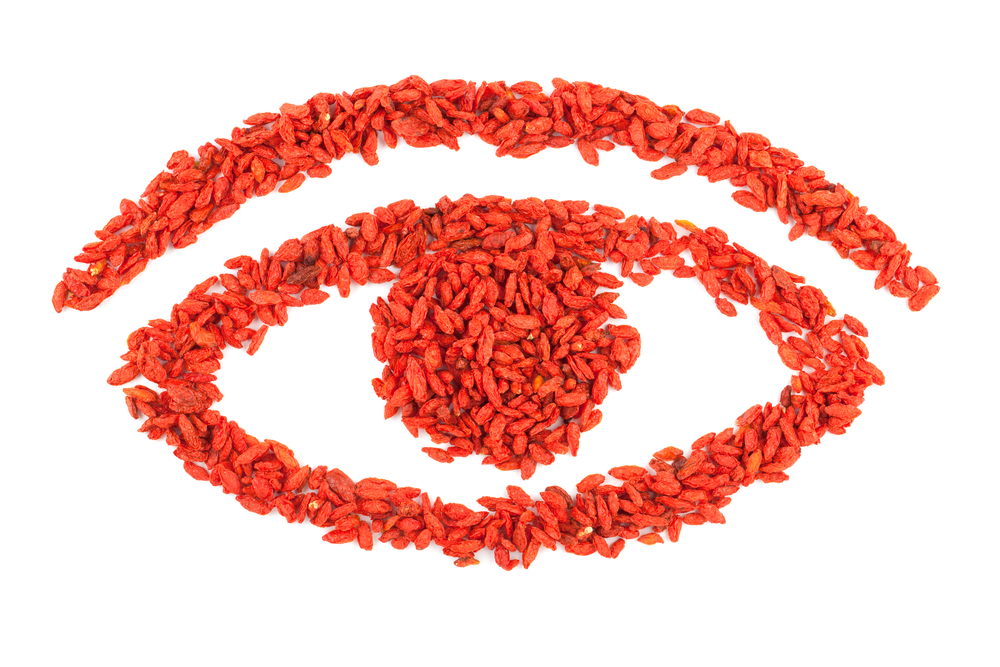If you live in Asia, you’ll be familiar with the goji berry (or Chinese wolfberry). Native to the region, this brightly colored red berry has been used as a medicinal herb and food supplement for more than 2,000 years. It is a key ingredient in traditional Chinese medicine and is said to offer a host of benefits, including nourishing and tonifying the liver and kidneys, increasing energy and brightening eyes.
In the West, goji berries are dubbed as a superfood due to their phytochemical contents, namely polysaccharides and carotenoids (i.e., lutein, zeaxanthin and beta-carotene), which exert powerful antioxidant mechanisms. In the eye’s macular region, lutein and zeaxanthin work to quench singlet oxygen and scavenge free radicals, protecting the cells from free radical damage. Lutein also has the ability to filter blue light, thus reducing phototoxic damage to photoreceptor cells.1 A reduction of these antioxidants over time is thought to impair eye function.
In goji berries, the carotenoid content ranges from 0.03 to 0.5% in dried fruits;2 this is responsible for the berries’ characteristic bright and vivid orange to red coloration. The carotenoid zeaxanthin comes in the form of dipalmitin zeaxanthin and in ripening goji berries, the content of zeaxanthin can reach about 77.5% of total carotenoids.2
Consuming 15 g of goji berries per day would supply adequate zeaxanthin (estimated at 3 mg/day) to support eye health3 and 20 g in a simple tea can improve decreased visual perception.4
The Goji Effect on AMD
A randomized, unmasked, parallel-arm study published recently in the peer-reviewed journal Nutrients, examined the effects of goji berry intake on skin carotenoids and macular pigment optical density (MPOD) in healthy individuals.5 A biomarker for age-related macular degeneration (AMD), MPOD reflects the levels of macular pigment (MP), which is composed of lutein, zeaxanthin, and meso-zeaxanthin.
The study involved 27 participants, aged 45-65, who consumed either 28 g of goji berries or a supplement containing 6 mg lutein and 4 mg zeaxanthin, five times weekly for 90 days. After 90 days, MPOD was significantly increased in the goji berry group at 0.25 and 1.75 retinal eccentricities (p = 0.029 and p = 0.044, respectively), while no changes were noted in the lutein-zeaxanthin group. The goji berry group has significantly higher levels of skin carotenoids at day 45 (p = 0.025) and day 90 (p = 0.006), but not the lutein-zeaxanthin group. Therefore, the authors concluded that regular intake of goji berries in a healthy middle-aged population may help prevent or delay the development of AMD.
“Lutein and zeaxanthin are like sunscreen for your eyes. The higher the lutein and zeaxanthin in your retina, the more protection you have. Our study found that even in normal healthy eyes, these optical pigments can be increased with a small daily serving of goji berries,” said lead author Xiang Li.6
The form of zeaxanthin in goji berries is also highly bioavailable, which means it is readily absorbed in the digestive system and can be used by the body.6
“Our study shows goji berries, which are a natural food source, can improve macular pigments of healthy participants beyond taking high-dose nutritional supplements,” said study researcher Glen Yiu.6
Further, a 2018 study from Taiwan demonstrated the benefits of goji berries on dry eye disease in rats.7 The study indicated that goji berry consumption ameliorates the symptoms of dry eye disease by enhancing tear volume and repairing damaged ocular surface cells.
With such prominent benefits to eye health, it is certainly wise to include these little red gems regularly in your diet by adding them to meals, or taking them as a snack.
References
- Buscemi S, Corleo D, Di Pace F, et al. The Effect of Lutein on Eye and Extra-Eye Health. Nutrients. 2018; 10(9): 1321.
- Ma ZF, Zhang H, Teh SS. Goji Berries as a Potential Natural Antioxidant Medicine: An Insight into Their Molecular Mechanisms of Action. Oxid Med Cell Longev. 2019; 2019: 2437397.
- Cheng CY, Chung WY, Szeto YT, Benzie IF. Fasting plasma zeaxanthin response to Fructus barbarum L. (wolfberry; Kei Tze) in a food-based human supplementation trial. Br J Nutr. 2005;93(1):123-130.
- Amagase H, Farnsworth NR. A review of botanical characteristics, phytochemistry, clinical relevance in efficacy and safety of Lycium barbarum fruit (goji). Food Res Int. 2011;44(7):1702–1717.
- Li X, Holt RR, Keen CL, et al. Goji Berry Intake Increases Macular Pigment Optical Density in Healthy Adults: A Randomized Pilot Trial. Nutrients. 2021;13(12):4409.
- Dried goji berries may provide protection against age-related vision loss. Science Daily. Available here: https://www.sciencedaily.com/releases/2022/01/220113151356.htm Accessed on January 31, 2022.
- Chien K-J, HOrng C-T, Huang Y-S, et al. Effects of Lycium barbarum (goji berry) on dry eye disease in rats. Mol Med Rep. 2018; 17(1): 809–818.



